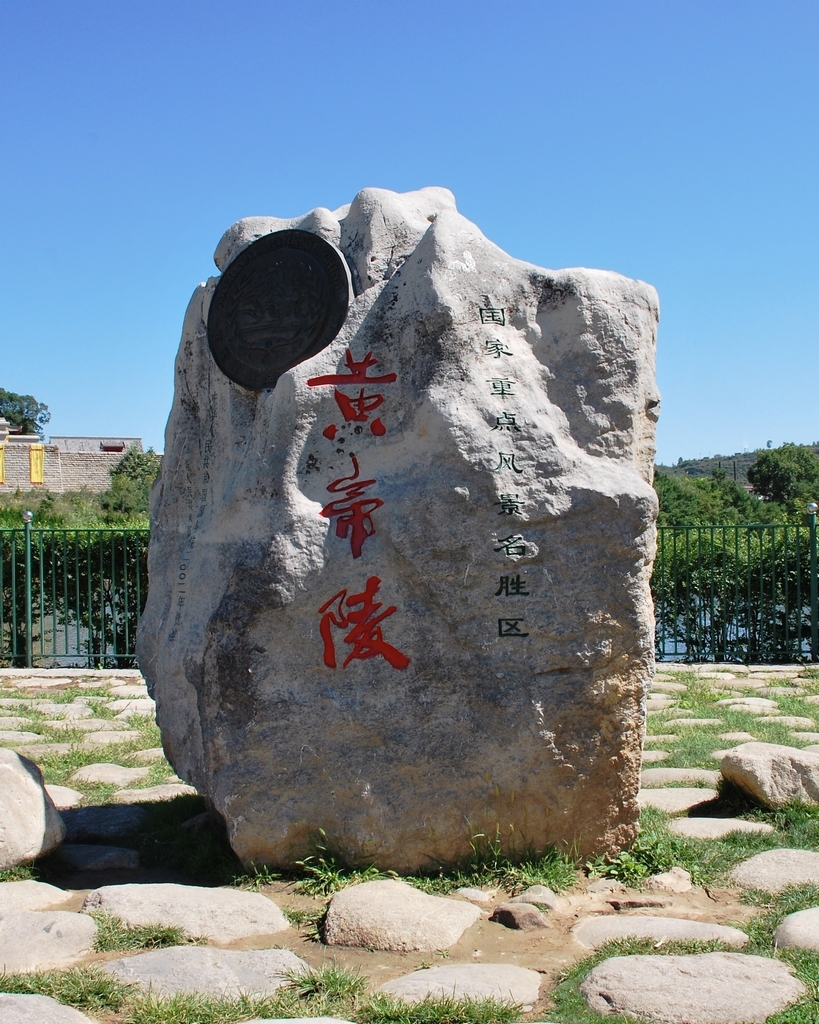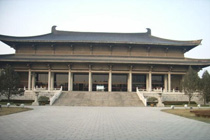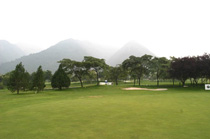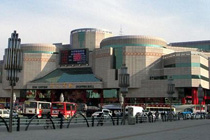The Mausoleum of Yellow Emperor, memorial mausoleum of legendary Yellow Emperor, is the most important ancient grave site in China. After many years' development and construction, the mausoleum became not only a mausoleum, but a key point of interest for historical Chinese culture. The main sights in this scenic spot are Mausoleum of Yellow Emperor and Xuanyuan Temple. Before visiting this location, one should know about Yellow Emperor in detail.

Yellow Emperor, the initiator of Chinese civilization, was a great tribal leader in the final primitivesociety of ancient China. His family name was Gongsun. Because he grew up at Xuanyuan Hill (in Xinzheng County of Henan Province), he was called Xuanyuan. He worshipped the virtue of the yellow earth (the source of foods and clothes); hence people call him Yellow Emperor. It is said that 5000 years ago, Yellow Emperor cooperated with Yandi to defeat the Chiyou tribe, then unified the other tribes and established the Hua Xia nationality (the former name of the Chinese Nation). Yellow Emperor was able to make weapons, vessels and vehicles, and to raise silkworms. He and his contemporaries created the characters, instruments, medicines and counting systems etc, which ended the savage and wild period. Yellow Emperor is remembered in history for punishing evils and for the first unification of the Chinese Nation. It is said that Yellow Emperor lived for 118 years. Once during his tour in Henan Province, a yellow dragon fell down from the heaven after a thunderbolt. The dragon said to Yellow Emperor: 'Your task is finished. You should follow me to heaven.' Yellow Emperor knew he could not disobey destiny so he rode on the dragon. As they flew over Mt. Qiao, Yellow Emperor asked to be allowed to go down to comfort his country. People cried out and came here; they pulled on Yellow Emperor's clothes to try to keep him on earth, but it was in vain. He only left his clothes. Afterwards, people buried Yellow Emperor's clothes here and established the mausoleum. Some writings claim Yellow Emperor himself was buried here.
The Mausoleum of Yellow Emperor is the tomb of Yellow Emperor, hidden inside the dense evergreen cypresses on Mt. Qiao (Bridge). Mt. Qiao won the name because it looks like a bridge. More than 8000 cypresses on Mt. Qiao, most alive for thousands of years, form the largest old cypress forest in China. The Mausoleum of Yellow Emperor is called the First Mausoleum of China and is located in the center of the top of Mt. Qiao, 1 kilometer (about 0.6 miles) north of Huangling County, Yan'an City. Covering an area of 4 square kilometers (about 1.5 square miles), The Mausoleum of Yellow Emperor is surrounded by a verdant forest and clear water. When you reach the top of Mt. Qiao, a stone stele will first catch your eye. In front of the mausoleum is a pavilion, where stands another tall stone stele displaying the characters of 'Huangdiling'. Then you see the tomb of Yellow Emperor. It is a 4-meter-high (4.4 yards) mound, around which is a 1-meter-high (about 1.1 yards) brick-wall. In Chinese history, many emperors held memorial ceremonies to Yellow Emperor. About 40 meters (about 43.7 yards) ahead of the tomb is a platform called 'Hanwu Xiantai', where Emperor Wu of the Han Dynasty (206 BC - 24) held ceremonies honoring Yellow Emperor. Longyu Pavilion is a remarkable structure in the tomb area. Its fanciful architecture stands 5 stories and 20 meters (about 21.9 yards) high, and tourists may walk up steps to overlook Mt. Qiao and Huangling County. Since Longyu Pavilion is the highest point in the tomb area, it is also used for spotting fires. When you climb up Longyu Pavilion, you may clearly see Mt. Yintai, located to the south of Mt. Qiao. The shape of the mountain reminds one of a big Yintai (great seal), so people call it Mt. Yintai. Interesting sights on the east and west hillsides are abundant: the mazes, forests and clear waters here feel secret, deep and remote. Another interesting view is that of Mt Qiao from the top of Mt Yintai.
Xuanyuan Temple is also named the Temple of Yellow Emperor, established in the Ming Dynasty (1368 --- 1644). The main structures inside the temple are Temple Gate, Chengxin Kiosk, Stele Pavilion and 'Renwen Chuzu' (Huangdi, the initiator of Chinese civilization) Hall. Inside the grand 'Renwen Chuzu' Hall, Yellow Emperor's seat of spirit tablet (an exquisite piece of wood with his name on it) is worshipped. People can do obeisance or hold ceremonies in front of it. Among 14 cypresses in the courtyard, the must-see ones are two: the cypress planted by Huangdi and the Jiangjun (general) cypress. It is said that Yellow Emperor planted the cypress thousands of years ago to encourage planting of trees and forestation. Now the huge green umbrella is 19 meters high (about 20.8 yards) and is the oldest cypress in the world. There is another legend about the Jiangjun cypress that says Emperor Wu of Han Dynasty ever hung his visor on the pine, so people call it Jiangjun cypress. It is also a rare type of cypress. Situated in the west portion of the Temple of Yellow Emperor is the Gongde (merits and virtues) Altar, the theme of which is the outstanding achievements of Yellow Emperor. Gongde Altar is a round platform with three concentric cylindrical walls on which embossed characters describe Yellow Emperor and his country's contribution to human progress. The altar is surrounded by 33 stone steles (representing 33 provinces of China) called China Tongxin (meaning 'with one heart') Stone Steles, symbolizing the solidarity of the Chinese Nation.
Yellow Emperor made great contributions to Chinese civilization and the role of China among the four ancient civilized countries in the world. Today, the Mausoleum of Yellow Emperor, the center of magnificent cultural activity in China, is the symbol of Chinese civilization and the 'root' of the Chinese Nation. For thousands of years, every Tomb-Sweeping Day swarms of people have come here to hold a memorial ceremony to Yellow Emperor.
Address: Huangling County, Shaanxi Province
 Xi’an is not only a historical and culture city, but also a trendy city permeated with modern tempo
Xi’an is not only a historical and culture city, but also a trendy city permeated with modern tempo
 Ancient capital Xi'an, the tourism dream is over the time
Ancient capital Xi'an, the tourism dream is over the time
 The cultural and historical significance of the area, as well as the abundant relics and sites, help Xian enjoy the laudatory title of 'Natural History Museum'
The cultural and historical significance of the area, as well as the abundant relics and sites, help Xian enjoy the laudatory title of 'Natural History Museum'
 Countless ancient architecture and valuable historical relics have been preserved above and under the ground
Countless ancient architecture and valuable historical relics have been preserved above and under the ground
 Culture Qin:Museum of Qin Terra-cotta Warriors and Horses
Culture Qin:Museum of Qin Terra-cotta Warriors and Horses
 It is the first multi-functional museum complex which integrates museum, monuments and park
It is the first multi-functional museum complex which integrates museum, monuments and park
 As the symbol of the old-line Xian, Big Wild Goose Pagoda is a well-preserved ancient building and a holy place for Buddhists
As the symbol of the old-line Xian, Big Wild Goose Pagoda is a well-preserved ancient building and a holy place for Buddhists
 Tang Paradise is located in the Qujiang Resort, southeast of the Xian City, Shaanxi Province
Tang Paradise is located in the Qujiang Resort, southeast of the Xian City, Shaanxi Province
 Grand Park Hotel Xi’an
Grand Park Hotel Xi’an
 Xi'an Train Station is ranked as Class A by the nation standard with all the modern facilities
Xi'an Train Station is ranked as Class A by the nation standard with all the modern facilities
 the Chinese dumpling has a long history and is an essential part of celebra-tory meals such as those prepared for the Chinese lunar Spring Festival
the Chinese dumpling has a long history and is an essential part of celebra-tory meals such as those prepared for the Chinese lunar Spring Festival
 This is the famous Halal snacks street in ancient Xi’an City and the only professional food market that runs exclusive Halal food
This is the famous Halal snacks street in ancient Xi’an City and the only professional food market that runs exclusive Halal food
 the Grand Hongkong Restaurant has won many honors and titles
the Grand Hongkong Restaurant has won many honors and titles
 Lying at the foot of Zhongnan Mountain, Xi’an Yajian International Golf Club covers an area of over 214 acres
Lying at the foot of Zhongnan Mountain, Xi’an Yajian International Golf Club covers an area of over 214 acres
 Located just inside the South Gate, Park Qin with the unique decoration to the variety of drink specials
Located just inside the South Gate, Park Qin with the unique decoration to the variety of drink specials
 Kai Yuan Shopping Mall is regarded as one of the biggest shopping mall in Xi'an
Kai Yuan Shopping Mall is regarded as one of the biggest shopping mall in Xi'an
